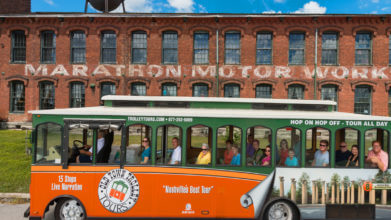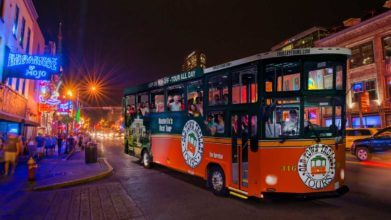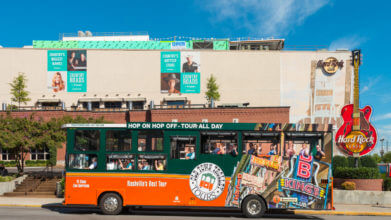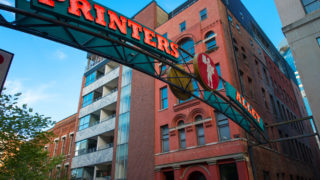National Museum of African American Music
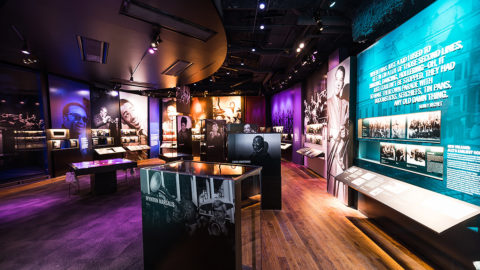
The National Museum of African American Music explores the rich history of black music, touching on more than 50 genres and styles, including spirituals, blues, jazz, gospel, R&B, and hip-hop. Featuring six interactive galleries equipped with state-of-the-art technology, the museum’s mission is to educate and transform the appreciation of African American music history and culture.
The National Museum of African American Music is the only museum in the country dedicated to preserving and celebrating the impact of African-American artists across multiple genres. Located in the heart of downtown, this museum showcases more than 50 musical styles, highlighting how African-American musicians have helped shape everything from blues and gospel to jazz, R & B and hip-hop. Through immersive exhibits, rare artifacts, and interactive displays, visitors gain a deeper understanding of how this influence shaped the sound of America.
For those looking to experience Nashville museums beyond country music, this museum is a must-visit. Its central location makes it easy to explore in a day, offering a comprehensive look at Nashville music history while placing visitors within walking distance of other major sites. This guide explores the museum’s highlights, from historic recordings and memorabilia to hands-on exhibits that bring the evolution of music to life.
History of African-American Music in Nashville
The role of African-American musicians in Nashville music history dates back long before the city became famous for country music. While often overlooked, their contributions helped shape the foundation of Music City.
The Fisk Jubilee Singers: A Global Influence
The Fisk Jubilee Singers, a vocal group from Fisk University, introduced the world to spirituals in the 19th century. Their international tours helped establish Nashville as a city of musical excellence long before it was known for country. Today, their legacy is honored throughout the city, and their influence continues in the gospel and R & B sounds of modern artists.
Jefferson Street’s Musical Impact
During the mid-20th century, Jefferson Street was a thriving hub for R & B, jazz, and blues. Legendary artists like Little Richard, Jimi Hendrix and Ray Charles performed in the area’s clubs, drawing music lovers from across the country. Though urban development changed the district over time, its legacy remains a critical piece of Nashville music history.
African-American Artists in Nashville’s Music Scene Today
African-American musicians continue to shape the industry in Nashville, contributing to country, hip-hop, gospel and R&B. While the city is often associated with country music, the National Museum of African American Music ensures that these diverse influences are recognized as essential to Nashville music history.
Museum Overview: Mission, Vision & Location
The Mission of NMAAM: Honoring a Musical Legacy
The National Museum of African American Music exists to document, educate and celebrate African-American contributions to music. Visitors explore how different genres evolved, learning how each style influenced and inspired the next. The museum provides an immersive experience that allows guests to see, hear and interact with these musical milestones.
Where To Find the Museum
Situated at 510 Broadway, the museum is located in the Fifth + Broadway development, a prime spot among top Nashville museums. The 56,000-square-foot facility includes galleries, performance spaces, and interactive exhibits that bring the story of African-American music to life. Visitors can easily explore other Nashville attractions, including the Country Music Hall of Fame, Ryman Auditorium, and Bridgestone Arena.
Exhibits and Interactive Galleries: A Journey Through Music History
Each gallery at the National Museum of African American Music provides a deep dive into the evolution of sound, tracing how musical traditions developed over time.
Roots Theater: A Cultural Introduction
The Roots Theater offers a multimedia experience that introduces the origins of African-American music. Through visual storytelling and original recordings, visitors learn how African influences shaped spirituals, blues, and gospel.
Rivers of Rhythm Pathways: The Evolution of Sound
The Rivers of Rhythm Pathways exhibit follows the development of music from early African rhythms to contemporary hip-hop. Interactive displays allow visitors to explore how different genres emerged, making it one of the most engaging sections of the museum.
Wade in the Water: Gospel and Spirituals
The Wade in the Water exhibit explores the connection between faith and music in African-American culture. Featuring recordings of Mahalia Jackson and Kirk Franklin, this gallery shows how spirituals evolved into gospel, influencing soul, R & B, and even hip-hop.
Crossroads: The Blues and Its Influence
The Crossroads exhibit traces the blues from its origins in work songs and field hollers to its role in shaping rock and roll. Visitors can see artifacts from legendary musicians like B.B. King and Muddy Waters, exploring how the blues set the stage for modern music.
A Love Supreme: The Global Impact of Jazz
Jazz is highlighted in A Love Supreme, an exhibit that celebrates artists like Duke Ellington, Ella Fitzgerald and Louis Armstrong. Live performances bring this genre to life, allowing guests to experience the improvisation and creativity that define jazz.
The Message: Hip-Hop and Social Change
This exhibit tells the story of hip-hop’s rise from New York block parties to international influence. It showcases pioneers like Run-D.M.C. and Tupac while highlighting hip-hop’s role in shaping conversations about race, culture and politics.
Collections and Artifacts: Rare Memorabilia and Historical Treasures
Musical Instruments: The Tools of Legendary Artists
The National Museum of African American Music houses a remarkable collection of instruments used by some of the most influential musicians in history. These pieces connect visitors to the sound and style that defined generations of music.
- Jimi Hendrix’s Fender Stratocaster – One of the most recognizable guitars in rock and blues, played by Hendrix during his groundbreaking performances.
- Ray Charles’ Custom Yamaha Piano – A grand piano used by the legendary musician, known for blending gospel, jazz, and soul in a way that reshaped Nashville music history.
- Prince’s “Purple Rain” Guitar – A uniquely designed guitar associated with his iconic performances and innovative approach to music.
These instruments serve as a tribute to the artists who transformed the industry and continue to influence modern musicians. The collection highlights the impact of African-American artists on every genre, making it an essential stop for those exploring Nashville museums.
Costumes and Performance Attire: Defining Stage Presence
Fashion has always played a major role in music, and the museum’s collection of stage costumes reflects the evolution of performance style.
- Diana Ross’ Signature Gown – Worn during The Supremes’ peak years, showcasing the elegance of Motown.
- James Brown’s Cape and Jumpsuit – A bold and dynamic outfit that became a signature of his high-energy performances.
- Beyoncé’s Tour Wardrobe – Pieces from her most celebrated performances, highlighting the evolution of modern pop and R & B fashion.
These iconic outfits give visitors a glimpse into the artistry behind live performances and how visual presentation became just as important as the music itself.
Vinyl Records and Sheet Music: The Evolution of Sound
The museum’s collection of rare records and original sheet music highlights the foundational works of African-American musicians.
- Rare Vinyl Records – First pressings of landmark albums from legends like Aretha Franklin, Sam Cooke and Otis Redding.
- Handwritten Lyrics – Original drafts from artists like Stevie Wonder and Nina Simone, revealing their creative process.
- Historic Sheet Music – Carefully preserved compositions that provide insight into the technical artistry of jazz, blues, and gospel musicians.
These artifacts showcase how early recordings and written compositions shaped Nashville music history and beyond.
Educational Programs and Special Events: Engaging Experiences for Visitors
Workshops and Seminars: Hands-On Learning
The National Museum of African American Music offers interactive educational experiences that allow visitors to dive deeper into the creative process behind some of the most influential genres in American music.
- Music Production Workshops – Learn about recording, mixing, and producing music using industry-standard techniques.
- Songwriting Sessions – Break down the structure of a hit song with guidance from experienced musicians.
- Historical Lectures – Explore how African-American artists shaped blues, jazz, gospel and hip-hop.
These programs provide a deeper understanding of how music has evolved and the role African-American artists played in shaping popular culture.
Live Performances and Artist Talks: Bringing History to Life
The museum frequently hosts live performances and discussions featuring well-known musicians, historians, and industry professionals.
- Jazz and Blues Nights – Showcasing the influence of African-American musicians on the global music scene.
- Hip-Hop and R & B Showcases – Exploring the impact of modern Black artists on mainstream culture.
- Guest Speaker Series – Featuring legendary musicians, producers, and historians discussing the evolution of music.
These events provide a direct connection between past and present, ensuring that the contributions of African-American musicians continue to be celebrated.
Community Outreach and Youth Programs: Inspiring the Next Generation
As part of its mission, the museum invests in community programs that encourage young artists and students to explore their musical talents.
- School Partnerships – Collaborations with local schools to introduce students to African-American music history.
- Interactive Learning Exhibits – Hands-on experiences that allow visitors to experiment with instruments and production tools.
- Mentorship Programs – Opportunities for emerging artists to receive guidance from industry professionals.
By engaging with students and young musicians, the museum ensures that the legacy of African-American music will continue for generations.
Visitor Information: Plan Your Trip to NMAAM
Hours and Admission: What To Expect When Visiting
The National Museum of African American Music is one of the most unique Nashville museums, offering an immersive experience in a state-of-the-art facility.
Address: 510 Broadway, Nashville, TN 37203
Operating Hours:
- Tuesday-Saturday: 10:00 am-5:00 pm
- Sunday: 12:00 pm-5:00 pm
Admission Prices:
- Adults: $24.95
- Students and Seniors: Discounted rates available
- Children Under 7: Free entry
Visitors are encouraged to check the museum’s website for the latest information on ticket prices and availability.
Accessibility and Facilities: Ensuring a Comfortable Experience
The National Museum of African American Music is designed to be accessible to all guests, with features that enhance the visitor experience.
- Wheelchair Accessibility – Elevators and ramps are available throughout the facility.
- Assistive Listening Devices – Available for guided tours and exhibits.
- Guided Tours – Knowledgeable docents provide deeper insights into each exhibit.
- Museum Store – A selection of music-related books, souvenirs, and exclusive memorabilia.
With its central location and engaging exhibits, the museum is an essential stop for anyone interested in Nashville music history. And getting to this and other Nashville museums is made simple with Old Town Trolley Tours®. This hop-on, hop-off tour allows you to experience the best of Nashville without the stress of parking.
Nearby Attractions: More To See in Downtown Nashville
Ryman Auditorium: A Legendary Music Venue
The Ryman Auditorium is one of the most significant landmarks in Nashville music history, known for its deep connection to American music. Built in 1892 as a gospel revival hall, it later became the home of the Grand Ole Opry, shaping Nashville’s reputation as “Music City.”
- Concerts and Live Performances – The Ryman continues to host world-class musicians across all genres, from rock and jazz to folk and blues. Many legendary African-American artists, including B.B. King and Aretha Franklin, have performed on this historic stage.
- Historic Exhibits – Visitors can tour the venue to see costumes, instruments, and memorabilia from influential performers. The Ryman’s exhibits highlight the role African-American musicians played in shaping Nashville music history, showcasing blues, gospel, and early rock influences.
- Behind-the-Scenes Access – Self-guided and guided tours provide an inside look at the venue’s transformation over the years. Guests can stand on the same stage where music legends have performed and explore interactive displays detailing the Ryman’s evolution.
Just a short walk from the National Museum of African American Music, the Ryman Auditorium stands as a must-visit for those exploring Nashville museums and the city’s deep musical heritage.
Country Music Hall of Fame: Celebrating Musical Icons
The Country Music Hall of Fame is a cornerstone of Nashville music history, preserving the stories of artists who shaped country music while also highlighting how the genre intersects with blues, gospel, and R & B.
- Rare Music Artifacts – The museum houses a vast collection of personal belongings, handwritten lyrics, and instruments from famous musicians. Visitors can see guitars once owned by Ray Charles and Charley Pride, two artists who bridged the gap between country and R & B.
- Hall of Fame Rotunda – This exhibit honors influential artists in country music history, many of whom were inspired by gospel, blues, and jazz traditions found at the National Museum of African American Music.
- RCA Studio B Tour – Visitors can step inside this historic recording studio, where icons like Elvis Presley, Fats Domino and the Everly Brothers recorded groundbreaking music. This tour offers a rare glimpse into the studios that helped define Nashville music history.
Even those who aren’t country music fans will appreciate the connections between the exhibits at the National Museum of African American Music and the broader evolution of American sound.
Fifth + Broadway: A Hub for Dining, Shopping and Entertainment
Located steps away from the National Museum of African American Music, Fifth + Broadway is one of the most popular destinations in the city.
- Diverse Dining Options – The district features a variety of restaurants, including Assembly Food Hall, where visitors can sample Southern comfort food, international cuisine, and plant-based options.
- Boutique Shopping – A mix of locally owned stores and national brands provides a variety of retail options. Visitors can explore unique shops offering everything from handcrafted leather goods to music memorabilia celebrating Nashville music history.
- Live Music and Events – Fifth + Broadway frequently hosts performances and pop-up events, adding to the city’s energetic atmosphere. Street musicians and local artists contribute to the dynamic soundscape that defines Downtown Nashville.
This entertainment center offers a great place to take a break after visiting Nashville museums or exploring the exhibits at NMAAM.
FAQs
What genres of music are represented at NMAAM?
The National Museum of African American Music highlights over 50 genres, including blues, jazz, gospel, R & B, hip-hop, and rock. The exhibits explore how African-American musicians influenced Nashville music history and shaped the sound of modern music.
Are there interactive exhibits at the museum?
Yes, the museum provides immersive experiences where visitors can listen to historic recordings, use touchscreens to explore music’s evolution, and even try virtual music-making activities. These hands-on displays set NMAAM apart from other Nashville museums.
Can I attend live performances at NMAAM?
The museum frequently hosts concerts, panel discussions, and special events featuring artists from multiple genres. Whether it’s a jazz night or a hip-hop showcase, visitors can experience live music as part of Nashville’s music history.
How long does it take to tour the museum?
Most visitors spend about two to three hours exploring the National Museum of African American Music, though those who engage deeply with the interactive elements may want to stay longer.
Is the museum family-friendly?
Yes! NMAAM offers educational programs designed for all ages, making it one of the most engaging Nashville museums for families. Children and adults alike can learn about music history through interactive exhibits and storytelling.
What other music-related attractions are near NMAAM?
In addition to the Ryman Auditorium and the Country Music Hall of Fame, visitors can explore attractions like the Johnny Cash Museum, the Musicians Hall of Fame, and the historic clubs of Printers Alley, all of which showcase different aspects of Nashville music history.
Is photography allowed inside the museum?
Photography is generally permitted in most areas of the National Museum of African American Music, but some exhibits may have restrictions. Flash photography and tripods are typically not allowed to preserve the integrity of artifacts.

